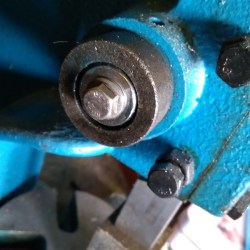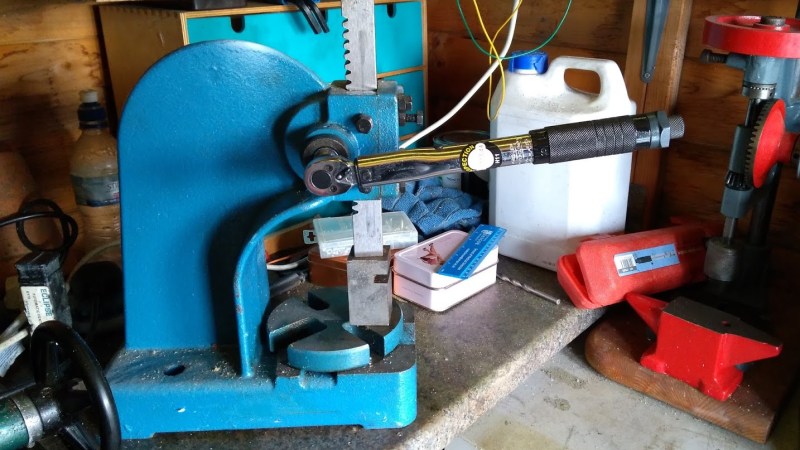Arbor presses are simple and effective tools made for a particular task: exerting force in a specific spot. A 1-ton arbor press fits on a desktop and is very affordable, but doesn’t offer a lot of particularly fine control over the ram beyond lowering and raising it. [concreted0g] got to thinking about ways to gain more control and knowledge about the amount of force being applied, and made a simple modification to combine his press with a torque wrench.
 He removed the spindle which raises and lowers the ram, and drilled and tapped it to fit a bolt. Now, by attaching a torque wrench to the bolt and using the wrench as the handle for lowering the ram, he can take advantage of the wrench’s ability to break at set amounts of force. As a result, he has a repeatable way to accurately apply specific amounts of force with a tool that usually lacks this ability. It looks like this mod is limited to lower forces only (too much could shear off the bolt head, after all) but it combines two tools in an unusual way to gain an ability that didn’t exist before, which is great to see. Mods and presses seem to go very well together; don’t miss this DIY thermal insert add-on for an arbor press, and 3D printed dies for a press brake turned out to be remarkably durable and versatile, not to mention economical.
He removed the spindle which raises and lowers the ram, and drilled and tapped it to fit a bolt. Now, by attaching a torque wrench to the bolt and using the wrench as the handle for lowering the ram, he can take advantage of the wrench’s ability to break at set amounts of force. As a result, he has a repeatable way to accurately apply specific amounts of force with a tool that usually lacks this ability. It looks like this mod is limited to lower forces only (too much could shear off the bolt head, after all) but it combines two tools in an unusual way to gain an ability that didn’t exist before, which is great to see. Mods and presses seem to go very well together; don’t miss this DIY thermal insert add-on for an arbor press, and 3D printed dies for a press brake turned out to be remarkably durable and versatile, not to mention economical.
















Not a spindle, its a pinion.
Well that’s a different O-Pinion. :P
If I want your o-pinion I will give it to you. ;)
Hmm, I was always taught that the spindle is a shaft that gears are mounted on and the pinion is the gear on the spindle, so he drilled and tapped the spindle and left the pinion alone.
I agree with you, for no other reason that with rack and pinion steering, the rack is the geared straight piece.
Same could be done by hanging a known weight off the handle. No bolt to shear off as a bonus.
So either you have a bunch of known weights laying around or you’ll be measuring out buckets of water for whatever force you needed for that job. After all that water juggling you’ll need to position whatever you’re pressing such that arm is horizontal when the force is applied or you’re going to need to measure that horizontal moment distance each time. Two fairly cumbersome measurements each time you want to use the thing will result in it gathering dust
Good idea. Maybe someone could also fit a strain gauge to the handle and figure a way to calibrate?
Torque wrench, so why?
“It looks like this mod is limited to lower forces only (too much could shear off the bolt head, after all) ” just thinking it would allow for a readout over the entire range of force, and even if you didn’t shear anything high load torque wrenches=$$
Meant to say original press handle not on the torque wrench handle.
Why the handle and not just in the base under whatever the load is
Welding a properly sized socket onto the shaft-end would allow you to snap in a torque wrench and apply all the forces in addition to using the original rod-through-shaft handle (using a longer thumbscrew to keep it in place that would protrude from the socket hole).
I would use a beam type torque wrench and not a snap type, but I like the idea.
Probably a good idea, particularly for fine pieces.
OTOH when you’re using it it could be hard to manage the workpieces and look at the wrench that’s alongside at the same time – the snap wrench allows you to watch the pieces you’re fumbling with and your thumb that’s about to be flattened.
Put a load cell between the circular base plate and the base so you can have a digital readout of the force? That way there’s an Arduino in the project :-)
I do like the idea of using one of those clicky torque wrenches for repeatability.
I considered using a press like that for a production fixture. But, on the display unit in the store, the rack/ram had too much lateral play in it – so I went another way. Can these cheap arbor presses be adjusted for anything close to precision work?
I did a setup at work for not percision but repeatable work on thousands of small parts, I added a small box sleeve of acetal delrin to act as a guide bushing just above the tool on the base
it did its job
While the torque wrench will read out the amount of torque that it applies, what is the amount of pressure that is applied after the gearing?
Exactly, this mod, while good only gives you repeatability, what you’re repeating is a mystery.
… but you can measure it and calibrate if you care.
You should be able to figure that out by the gear ratio. W=f x d. Like anything else, there will be some losses but that should get you in the ballpark. If you want to be exact, you could put a load cell in the press and do a few runs. It is never going to replace a MTS servo hydraulic system but for basement science it does not sound half bad.
You should be able to figure that out by the gear ratio. W=f x d. Like anything else, there will be some losses but that should get you in the ballpark. If you want to be exact, you could put a load cell in the press and do a few runs. It is never going to replace a MTS servo hydraulic system but for basement science it does not sound half bad given you can still use the arbor press as an arbor press.
We did this years ago in production. I should have written it up then…
One problem we found was that even though that torque wrench clicks, Susie Q will feel that she needs to pull it on just ever so much more afterward, you know, to make sure it’s good and crimped…
LOL.. its how we got nicer stuff on the production line, all hand clicker wrenches were removed and replaced with dc torque tools because of over torquing, of course the mindset doesn’t change so those people now feel that they need to apply a lot of force to the wrench to get the bolt to go in leading to stripped bolts and overheated tools. You cant idiot proof a process cause idiots are very clever…